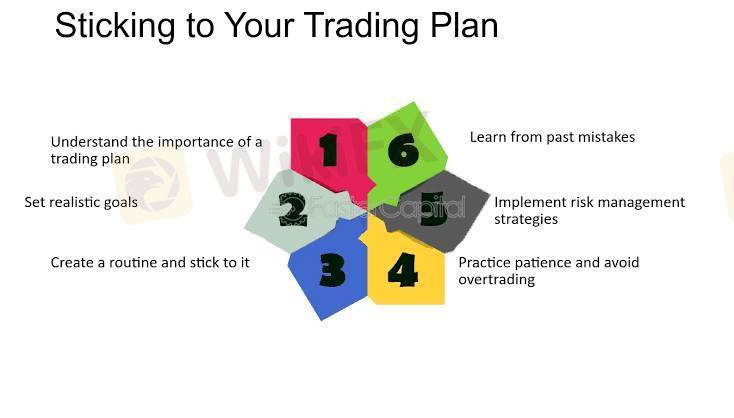
2025-02-18 04:04
IndustrySticking to a trading plan despite market fluctuat
#forexrisktip
Building a solid trading plan is essential for navigating the unpredictable world of financial markets. Here's a breakdown of key components and strategies to help you stay on track:
1. Define Your Objectives and Risk Tolerance
* Financial goals: What do you want to achieve with your trading? (e.g., long-term growth, supplemental income)
* Risk appetite: How much potential loss can you comfortably handle? This will influence your position sizing and stop-loss levels.
2. Develop a Trading Strategy
* Market analysis: Decide whether you'll focus on technical analysis (chart patterns), fundamental analysis (company news and financials), or a combination of both.
* Entry and exit rules: Clearly define the conditions that will trigger your trades, including specific indicators, price levels, or news events.
* Position sizing: Determine how much capital you'll allocate to each trade based on your risk tolerance and the potential reward.
3. Create a Detailed Trading Plan Document
* Written record: Formalize your strategy, including your objectives, risk tolerance, entry/exit rules, and position sizing guidelines.
* Regular review: Treat your trading plan as a living document. Review and adjust it periodically based on your performance and changing market conditions.
4. Stick to Your Plan
* Discipline: Avoid impulsive decisions driven by fear or greed. Trust your strategy and stick to your predefined rules.
* Emotional control: Market fluctuations can be stressful. Practice mindfulness or meditation to manage your emotions and avoid overreacting.
* Avoid chasing losses: Don't increase your risk to try to recoup losses quickly. This can lead to even bigger losses.
5. Track Your Progress
* Trading journal: Keep a detailed record of your trades, including entry and exit points, position size, and rationale.
* Performance analysis: Regularly review your trading journal to identify patterns, strengths, and weaknesses in your strategy.
* Adapt and improve: Use your performance data to refine your trading plan and make necessary adjustments.
Additional Tips
* Start small: Begin with a small amount of capital to gain experience and confidence.
* Educate yourself: Continuously learn about market dynamics, trading strategies, and risk management techniques.
* Seek mentorship: Consider learning from experienced traders or financial professionals.
* Stay informed: Keep up with market news and events that may affect your trades.
Remember:
* No trading plan can guarantee profits.
* Be prepared to adapt your plan as market conditions change.
* Consistent discipline and emotional control are crucial for long-term success.
Disclaimer: This information is for educational purposes only and should not be considered financial advice.
Like 0
Rona 5328
Trader
Hot content
Industry
Event-A comment a day,Keep rewards worthy up to$27
Industry
Nigeria Event Giveaway-Win₦5000 Mobilephone Credit
Industry
Nigeria Event Giveaway-Win ₦2500 MobilePhoneCredit
Industry
South Africa Event-Come&Win 240ZAR Phone Credit
Industry
Nigeria Event-Discuss Forex&Win2500NGN PhoneCredit
Industry
[Nigeria Event]Discuss&win 2500 Naira Phone Credit
Forum category

Platform

Exhibition

Agent

Recruitment

EA

Industry

Market

Index
Sticking to a trading plan despite market fluctuat
 India | 2025-02-18 04:04
India | 2025-02-18 04:04#forexrisktip
Building a solid trading plan is essential for navigating the unpredictable world of financial markets. Here's a breakdown of key components and strategies to help you stay on track:
1. Define Your Objectives and Risk Tolerance
* Financial goals: What do you want to achieve with your trading? (e.g., long-term growth, supplemental income)
* Risk appetite: How much potential loss can you comfortably handle? This will influence your position sizing and stop-loss levels.
2. Develop a Trading Strategy
* Market analysis: Decide whether you'll focus on technical analysis (chart patterns), fundamental analysis (company news and financials), or a combination of both.
* Entry and exit rules: Clearly define the conditions that will trigger your trades, including specific indicators, price levels, or news events.
* Position sizing: Determine how much capital you'll allocate to each trade based on your risk tolerance and the potential reward.
3. Create a Detailed Trading Plan Document
* Written record: Formalize your strategy, including your objectives, risk tolerance, entry/exit rules, and position sizing guidelines.
* Regular review: Treat your trading plan as a living document. Review and adjust it periodically based on your performance and changing market conditions.
4. Stick to Your Plan
* Discipline: Avoid impulsive decisions driven by fear or greed. Trust your strategy and stick to your predefined rules.
* Emotional control: Market fluctuations can be stressful. Practice mindfulness or meditation to manage your emotions and avoid overreacting.
* Avoid chasing losses: Don't increase your risk to try to recoup losses quickly. This can lead to even bigger losses.
5. Track Your Progress
* Trading journal: Keep a detailed record of your trades, including entry and exit points, position size, and rationale.
* Performance analysis: Regularly review your trading journal to identify patterns, strengths, and weaknesses in your strategy.
* Adapt and improve: Use your performance data to refine your trading plan and make necessary adjustments.
Additional Tips
* Start small: Begin with a small amount of capital to gain experience and confidence.
* Educate yourself: Continuously learn about market dynamics, trading strategies, and risk management techniques.
* Seek mentorship: Consider learning from experienced traders or financial professionals.
* Stay informed: Keep up with market news and events that may affect your trades.
Remember:
* No trading plan can guarantee profits.
* Be prepared to adapt your plan as market conditions change.
* Consistent discipline and emotional control are crucial for long-term success.
Disclaimer: This information is for educational purposes only and should not be considered financial advice.
Like 0
I want to comment, too
Submit
0Comments

There is no comment yet. Make the first one.

Submit
There is no comment yet. Make the first one.